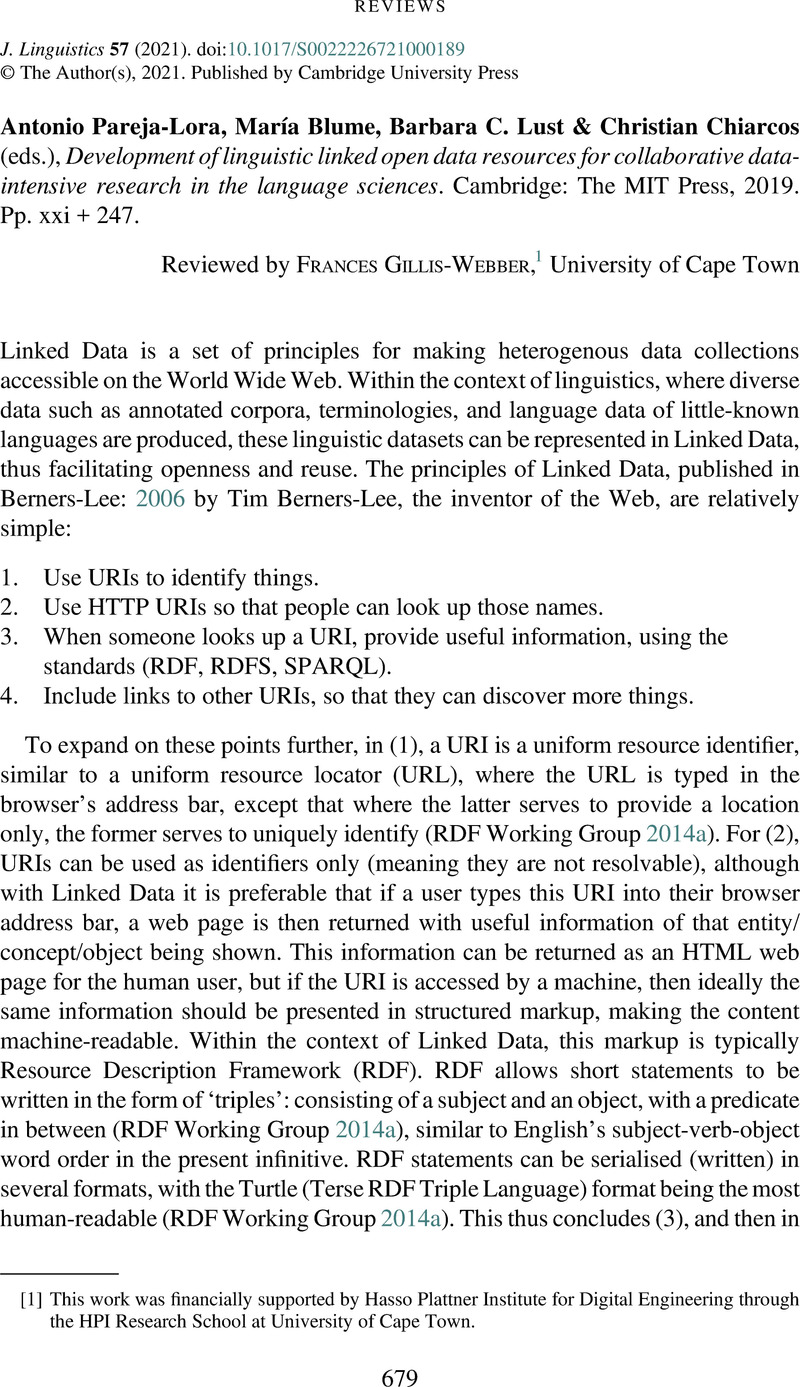No CrossRef data available.
Article contents
Antonio Pareja-Lora, María Blume, Barbara C. Lust & Christian Chiarcos (eds.), Development of linguistic linked open data resources for collaborative data-intensive research in the language sciences. Cambridge: The MIT Press, 2019. Pp. xxi + 247.
Review products
Antonio Pareja-Lora, María Blume, Barbara C. Lust & Christian Chiarcos (eds.), Development of linguistic linked open data resources for collaborative data-intensive research in the language sciences. Cambridge: The MIT Press, 2019. Pp. xxi + 247.
Published online by Cambridge University Press: 07 June 2021
Abstract
An abstract is not available for this content so a preview has been provided. Please use the Get access link above for information on how to access this content.

- Type
- Reviews
- Information
- Copyright
- © The Author(s), 2021. Published by Cambridge University Press
Footnotes
[1]
This work was financially supported by Hasso Plattner Institute for Digital Engineering through the HPI Research School at University of Cape Town.
References
Berners-Lee, Tim. 2006. Linked Data. https://www.w3.org/DesignIssues/LinkedData.html (accessed 10 March 2021).Google Scholar
Berners-Lee, Tim, Hendler, James & Lassila, Ora. 2001. The Semantic Web. Scientific American 284, 34–43.CrossRefGoogle Scholar
Chiarcos, Christian. n.d. Teach yourself LLOD. http://acoli.informatik.uni-frankfurt.de/resources/llod/ (accessed 10 March 2021).Google Scholar
Chiarcos, Christian, Fäth, Christian & Abromeit, Frank. 2020. Annotation interoperability for the post-ISOCat era. Proceedings of the 12th Conference on Language Resources and Evaluation (LREC 2020), 5668–5677.Google Scholar
Chiarcos, Christian & Sukhareva, Maria. 2015. OLiA — Ontologies of Linguistic Annotation. Semantic Web 6, 379–386. doi:10.3233/SW-140167.CrossRefGoogle Scholar
Cimiano, Philipp, Chiarcos, Christian, McCrae, John P. & Gracia, Jorge. 2020. Linguistic Linked Data: Representation, generation and applications. Cham: Springer. doi:10.1007/978-3-030-30225-2.CrossRefGoogle Scholar
Gillis-Webber, Frances & Tittel, Sabine. 2019. The shortcomings of language tags for Linked Data when modelling lesser-known languages. Proceedings of the 2nd Conference on Language, Data and Knowledge (LDK 2019), 4:1–4:15. Leipzig, Germany.Google Scholar
Gillis-Webber, Frances, Tittel, Sabine & Keet, C. Maria. 2019. A model for language annotations on the Web. In Villazón-Terrazas, Boris & Hidalgo-Delgado, Yusniel (eds.), Knowledge graphs and Semantic Web, 1–16. Cham: Springer.Google Scholar
Hammarström, Harald, Forkel, Robert, Haspelmath, Martin & Sebastian Bank. 2020. Glottolog 4.3. https://glottolog.org/glottolog/glottologinformation (accessed 13 March 2021).Google Scholar
RDF Working Group. 2014a. RDF 1.1 Primer: W3C Working Group Note 24 June 2014. https://www.w3.org/TR/rdf11-primer/ (accessed 10 March 2021).Google Scholar
RDF Working Group. 2014b. Resource Description Framework (RDF). https://www.w3.org/RDF/ (accessed 10 March 2021).Google Scholar



